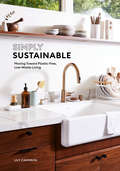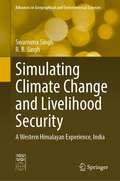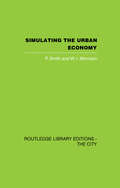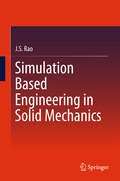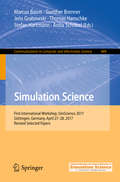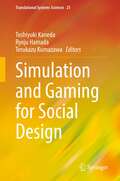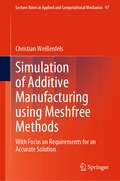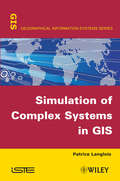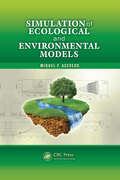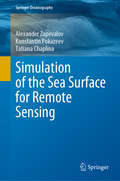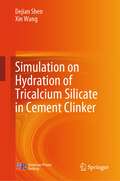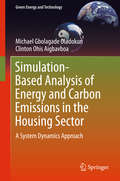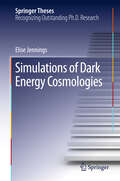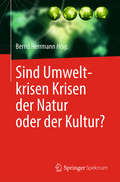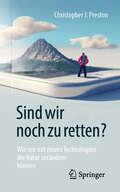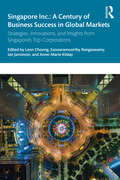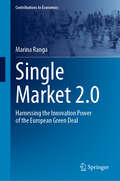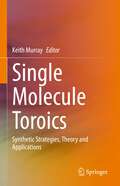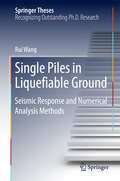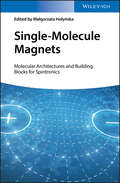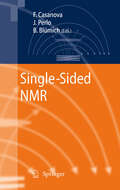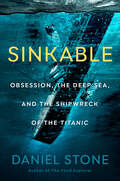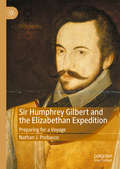- Table View
- List View
Simply Sustainable: Moving Toward Plastic-Free, Low-Waste Living
by Lily CameronBreak your plastic habit with simple, actionable steps and jumpstart your journey toward a minimal, beautiful, low-waste home.&“Simply Sustainable guides you through the why and how of zero-waste, while emphasizing the importance of finding the sweet spot between sustainability and self-care.&”—Julia Watkins, author of Simply Living WellTransitioning to a zero-waste lifestyle means eliminating unnecessary clutter from your home and reducing your dependence on disposable goods, but it also comes with practical challenges that can seem daunting. In Simply Sustainable, perfection is not required. Whether you are looking for easy changes to get you started, or more advanced, high-impact tips for your low-waste home, these simple, effective steps will forever change your relationship to disposable plastic products.Lily Cameron shows readers how to gradually transition away from plastic and curate a minimal, beautiful home in the process. Her approach teaches you how to "make plastic-free living work for you, savor your progress and celebrate that with each small change, you are making a positive impact on the environment, your health and your family's well being." Simply Sustainable proves that zero-waste living can be easy and deeply satisfying, whether shopping at the farmers market, throwing a dinner party, or packing for a getaway weekend. With practical, manageable strategies organized by room, and inspiring photographs of plastic-free homes, you can begin your journey toward intentional, low-waste living.
Simulating Climate Change and Livelihood Security: A Western Himalayan Experience, India (Advances in Geographical and Environmental Sciences)
by R. B. Singh Swarnima SinghThis book identifies and provides reasoning for computed methods of local climate dynamics and the livelihood vulnerability indices assessment in the mountainous region of Himachal Pradesh, India. The outcomes of this study agree with the focused objectives on simulating climate change and its impact on livelihood security. It deals with several crucial methodologies to analyze livelihood security with and without climate change. The explorative deductive approach was used to observe climatic changes since the 1970s and simulated the climate until 2080. Additionally, the composite livelihood vulnerability index (LVI) without climate change and the climate change livelihood vulnerability index (CCLVI) with climate change impact were prepared. The book is beneficial for policymakers who are involved in framing and implementing policies chiefly in the Himalaya. It is also valuable for all stakeholders in society: students, researchers and academicians. It proposes discussions and debate on a new, integrated, inclusive and open approach to climate change and validates the significance of geographic knowledge in addressing climate change issues at various levels, suggesting policy measures to cope with them.
Simulating the Urban Economy: Experiments with input-output techniques
by P. Smith W. I. MorrisonThis book was first published in it's current form in 1974.
Simulation Based Engineering in Solid Mechanics
by J. S. RaoThis book begins with a brief historical perspective of the advent of rotating machinery in 20th century Solid Mechanics and the development of the discipline of the Strength of Materials. High Performance Computing (HPC) and Simulation Based Engineering Science (SBES) have gradually replaced the conventional approach in Design bringing science directly into engineering without approximations. A recap of the required mathematical principles is given. The science of deformation, strain and stress at a point under the application of external traction loads is next presented. Only one-dimensional structures classified as Bars (axial loads), Rods (twisting loads) and Beams (bending loads) are considered in this book. The principal stresses and strains and von Mises stress and strain that used in design of structures are next presented. Lagrangian solution was used to derive the governing differential equations consistent with assumed deformation field and solution for deformations, strains and stresses were obtained. The finite element method most suitable for HPC is derived and the corresponding stiffness matrix for the element is derived. Assembling procedure of these matrices is then described to obtain the system matrices. Worked examples and exercises are given in each chapter. This book brings SBES at entry level allowing young students to quickly adapt to modern design practices.
Simulation Science: First International Workshop, Simscience 2017, Göttingen, Germany, April 27-28, 2017, Revised Selected Papers (Communications In Computer And Information Science #889)
by Stefan Hartmann Anita Schöbel Jens Grabowski Marcus Baum Gunther Brenner Thomas HanschkeThis book constitutes the thoroughly refereed proceedings of the Clausthal-Göttingen International Workshop on Simulation Science, held in Göttingen, Germany, in April 2017. The 16 full papers presented were carefully reviewed and selected from 40 submissions. The papers are organized in topical sections on simulation and optimization in networks, simulation of materials, distributed simulations.
Simulation Tools and Methods for Supercritical Carbon Dioxide Radial Inflow Turbine: Development and Application on Open-Source Code
by Jianhui QiTo protect the Earth, China has launched its target of peaking carbon dioxide emissions by 2030, and achieving carbon neutrality by 2060 , which greatly encourages the use and development of renewable energy. Supercritical CO2 power cycle is a promising technology and the radial inflow turbine is the most important component of it, whose design and optimisation are considered as great challenges. This book introduces simulation tools and methods for supercritical CO2 radial inflow turbine, including a high fidelity quasi-one-dimensional design procedure, a non-ideal compressible fluid dynamics Riemann solver within open-source CFD software OpenFOAM framework, and a multi-objective Nelder–Mead geometry optimiser. Enhanced one-dimensional loss models are presented for providing a new insight towards the preliminary design of the supercritical CO2 radial inflow turbine. Since the flow phenomena within the blade channels are complex, involving fluid flow, shock wave transmission and boundary layer separation, only employing the ideal gas model is inadequate to predict the performance of the turbine. Thus, a non-ideal compressible fluid dynamics Riemann solver based on OpenFOAM library is developed. This book addresses the issues related to the turbine design and blade optimization and provides leading techniques. Hence, this book is of great value for the readers working on the supercritical CO2 radial inflow turbine and understanding the knowledge of CFD and turbomachinery.
Simulation and Gaming for Social Design (Translational Systems Sciences #25)
by Toshiyuki Kaneda Ryoju Hamada Terukazu KumazawaThis book is a collection of research articles that deal with three aspects of simulation and gaming for social design: (1) Theory and methodology, including game system theory and agent-based modeling; (2) Sustainability, including global warming and the energy–food nexus);; and (3) Social entrepreneurship, including business, ethnic, and ethical understanding. The latter two especially form two major areas of clinical knowledge in contemporary life. Simulation and gaming, with its participatory approach, provides participants with a seamless integration of problem solving and education. It has been known as a tool for interdisciplinary communication since the 1960s, and now it is being developed to contribute to global society in the twenty-first century. This is the first book on simulation and gaming for social design that covers all aspects from the methodological foundations to practical examples in the fields of sustainability and social entrepreneurship. Regardless of the size of the problematics, societal system design involves (1) The visioning and conception aspects due to the long-term, overall nature of the goal; (2) Interdisciplinary thinking and communication for the exploration of new states of accommodation with technological systems; and (3) The “human dimension” aspect including education that must be dealt with, thus academic developments of simulation and gaming for social design as system thinking and practice methodologies are anticipated. Simulation and gaming has great potential for development as a tool to facilitate the transfer between theoretical and clinical knowledge.
Simulation of Additive Manufacturing using Meshfree Methods: With Focus on Requirements for an Accurate Solution (Lecture Notes in Applied and Computational Mechanics #97)
by Christian WeißenfelsThis book provides a detailed instruction to virtually reproduce the processes of Additive Manufacturing on a computer. First, all mathematical equations needed to model these processes are presented. Due to their flexibility, meshfree methods represent optimal computational solution schemes to simulate Additive Manufacturing processes. On the other hand, these methods usually do not guarantee an accurate solution. For this reason, this monograph is dedicated in detail to the necessary criteria for computational solution schemes to provide accurate results. Several meshfree methods are examined with respect to these conditions. Two different 3D printing techniques are presented in detail. The results obtained from the simulation are investigated and compared with experimental data. This work is addressed to both scientists and professionals working in the field of development who are interested to learn the secrets behind meshfree methods or get into the modeling of Additive Manufacturing.
Simulation of Complex Systems in GIS (Wiley-iste Ser.)
by Patrice LangloisThis book provides a comprehensive view of geographical modeling. It first establishes the foundations of geographical modeling, covering such concepts as structure, organization, system, topologies, as well as the concept of time. Next, it tackles the use of computer tools for dynamic model building and presents several models applied to various themes, such as urban growth, natural risks, as well as political themes. Finally, a general model of the geographic agents system (GAS), which can be used as a basis for the construction of a model-building platform for dynamic spatial models is presented.
Simulation of Ecological and Environmental Models
by Miguel F. AcevedoGiven the importance of interdisciplinary work in sustainability, Simulation of Ecological and Environmental Models introduces the theory and practice of modeling and simulation as applied in a variety of disciplines that deal with earth systems, the environment, ecology, and human-nature interactions. Based on the author's many years of teaching g
Simulation of the Sea Surface for Remote Sensing (Springer Oceanography)
by Konstantin Pokazeev Tatiana Chaplina Alexander ZapevalovThis book considers the formation of the signal reflected from the sea surface when sensing in the radio and optical range. Currently, remote sensing from space is the main source of information about the processes taking place in the atmosphere and ocean. The correct interpretation of remote sensing data requires detailed information about the rough surface that forms the reflected signal. The first three chapters describe the statistical and spatial-temporal characteristics of the sea surface, focusing on the effects associated with the nonlinearity of sea surface waves. The analysis makes extensive use of data obtained by the authors on a stationary oceanographic platform located on the Black sea. In the next seven chapters, the authors analyze how the nonlinearity of waves affects the formation of a signal reflected from the sea surface.This book is geared for advanced level research in the general subject area of remote sensing and modeling as they apply to the coastal marine environment. It is of value to scientists and engineers involved in the development of methods and instruments of remote sensing, analysis and interpretation of data. It is useful for students who have decided to devote themselves to the study of the oceans.
Simulation on Hydration of Tricalcium Silicate in Cement Clinker
by Xin Wang Dejian ShenThis book is written based on authors' research on cement hydration during the past decade. It establishes simulation model to evaluate the influence of crystal defects on the dissolution of tricalcium silicate and morphology change of particles and explores the hydration kinetics and microstructure development of tricalcium silicate under the mixed control of dissolution, diffusion, as well as boundary nucleation and growth. It also provides a theoretical basis for regulating the microstructure and performance of cement-based materials. It is designed as a reference work for professionals or practitioners and as a textbook for undergraduates or postgraduates. This book provides valuable knowledge and useful methods that can be applied in the field of cement hydration.
Simulation-Based Analysis of Energy and Carbon Emissions in the Housing Sector: A System Dynamics Approach (Green Energy And Technology)
by Michael Gbolagade Oladokun Clinton Ohis AigbavboaThis book describes the development of a system dynamics-based model that can capture the future trajectories of housing energy and carbon emissions. It approaches energy and carbon emissions in the housing sector as a complex socio-technical problem involving the analysis of intrinsic interrelationships among dwellings, occupants and the environment. Based on an examination of the UK housing sector but with relevance worldwide, the book demonstrates how the systems dynamics simulation can be used as a learning laboratory regarding future trends in housing energy and carbon emissions. The authors employ a pragmatic research strategy, involving the collection of both qualitative and quantitative data to develop a model. The book enriches readers’ understanding of the complexity involved in housing energy and carbon emissions from a systems-thinking perspective. As such, it will be of interest to researchers in the fields of architectural engineering, housing studies and climate change, while also appealing to industry practitioners and policymakers specializing in housing energy.
Simulations of Dark Energy Cosmologies
by Elise JenningsA major outstanding problem in physics is understanding the nature of the dark energy that is driving the accelerating expansion of the Universe. This thesis makes a significant contribution by demonstrating, for the first time, using state-of-the-art computer simulations, that the interpretation of future galaxy survey measurements is far more subtle than is widely assumed, and that a major revision to our models of these effects is urgently needed. The work contained in the thesis was used by the WiggleZ dark energy survey to measure the growth rate of cosmic structure in 2011 and had a direct impact on the design of the surveys to be conducted by the European Space Agency's Euclid mission, a 650 million euro project to measure dark energy.
Sind Umweltkrisen Krisen der Natur oder der Kultur?
by Bernd HerrmannDieses Buch macht die Beiträge eines Workshops der Nationalen Akademie der Wissenschaften LEOPOLDINA zum Thema Umweltkrisen in Heidelberg im November 2014 der Öffentlichkeit zugänglich. Hochkarätige Experten diskutierten anhand von Beispielen die Veränderungen, die aus solchen Krisen und langsamen Parameteränderungen erwachsen und die mit ihrer Wahrnehmung verbundenen Bewertungsprobleme. Dabei wird das Thema sowohl aus natur- wie auch aus geisteswissenschaftlicher Sicht beleuchtet.
Sind wir noch zu retten?: Wie wir mit neuen Technologien die Natur verändern können
by Christopher J. PrestonNanotechnologie, synthetische Biologie, Wiedererweckung ausgestorbener Arten und Geoengineering – werden Menschen die Natur in Zukunft mit solchen Methoden grundlegend umgestalten? Man könnte es sich vorstellen.Auf der Erde gibt es keinen von Menschen unberührten Ort mehr – das hat wohl jeder schon einmal gehört. Aber die Bedeutung dieser Tatsache erschöpft sich nicht in Statistiken, die Gletscherschmelze und Artensterben dokumentieren. Vielmehr kennzeichnet sie den Beginn einer neuen Epoche der Erdgeschichte. Und das Auffälligste an diesem Synthetischen Zeitalter, so Christopher Preston, sind nicht nur die Auswirkungen des Menschen als solche, sondern die Veränderungen, die wir von nun an gezielt und absichtlich herbeiführen werden. Neue Technologien werden uns die Macht verleihen, viele grundlegende Abläufe der Natur selbst in die Hand zu nehmen. Damit verlassen wir nicht nur das Holozän und treten ins Anthropozän ein; wir lassen auch eine Zeit hinter uns, in der globaler Wandel nicht nur die unbeabsichtigte Folge einer ungezügelten Industrialisierung ist. Mit einer von Ingenieuren und Technikern gestalteten Welt beginnt das erste Synthetische Zeitalter unseres Planeten.Preston beschreibt eine Reihe von Technologien, die den „Stoffwechsel“ der Erde umgestalten werden: Nanotechnologie gibt den natürlichen Formen der Materie eine neue Struktur; „molekulare Produktion“ eröffnet unzählige neue Anwendungsmöglichkeiten; synthetische Biologie erlaubt es uns, Genome nicht nur zu lesen, sondern auch aufzubauen; „biologische Mini-Maschinen“ überflügeln die Evolution; Arten werden umgesiedelt und wieder zum Leben erweckt; und mit Geoengineering kann man die Sonnenstrahlung mit Vulkandunst abschirmen, die Temperaturen auf der Erde durch hellere Wolken senken und mit künstlichen Bäumen, die Kohlenstoff aus Wind gewinnen, das CO2 aus der Atmosphäre beseitigen.Was bedeutet es, wenn Menschen die Erde nicht nur verwalten, sondern auch grundlegend umgestalten? Und wem sollten wir vertrauen, wenn es darum geht, über die Umrisse unserer synthetischen Zukunft zu entscheiden? Solche Fragen sind zu wichtig, als dass man sie den Ingenieuren überlassen sollte.
Singapore Inc.: Strategies, Innovations, and Insights from Singapore's Top Corporations
by Anne-Marie Kilday Leon Choong Easwaramoorthy Rangaswamy Ian JamiesonThis book features 100 local case studies examining the experiences of leading Singaporean companies across different sectors including aviation, logistics, banking, and real estate. They offer valuable insights into how companies adapted to evolving market dynamics, expanded their business portfolios, ventured into global markets, prioritised sustainability, and leveraged innovation and technology to maintain competitiveness. Through case studies, readers gain practical knowledge that can be applied to their own enterprises, a unique perspective into Singapore’s dynamic and competitive business landscape, and the successes and challenges faced by Singaporean companies. The book is divided into different sections exploring specific themes such as business strategy and transformation, diversification and expansion, sustainability, innovation and technology, financial performance, and risk management. It scrutinises how companies responded to shifting market conditions, competition, regulations, customer preferences, and global events. Additionally, it sheds light on the obstacles companies encountered in terms of sustainable practices, financial performance, risk management, talent retention, and technological advancements. By presenting cases across industries and companies in Singapore, Choong et al. highlight their triumphs, setbacks, and valuable lessons learned. This book can be rendered as a practical and essential resource for business professionals, entrepreneurs, and students interested in understanding effective business strategies.
Single Market 2.0: Harnessing the Innovation Power of the European Green Deal (Contributions to Economics)
by Marina RangaThis book examines the transformative power of the innovation processes set in motion by the European Green Deal and their impact on the EU Single Market. The book is structured into two parts: Part I examines the European Green Deal’s origins, drivers, and structure, highlighting its novel features and the holistic integration of sustainability across all EU policies. It sheds light on the history and evolution of EU environmental policies, tracing their development from the European Economic Community to the ambitious European Green Deal launched in December 2019. This part argues that the European Green Deal was the result of progressive integration of EU environmental objectives into a comprehensive regulatory body that has evolved organically at various institutional levels since the 1970s, and was galvanised by a nexus of scientific, societal, policy and political drivers that converged before December 2019, urging the adoption of a strategic and accelerated response to pressing climate challenges. Part II offers an original perspective on the EU Single Market from an ‘innovation systems’ perspective, centred on the quintessential structural element of the Single Market – the industrial ecosystem. Green Deal-related projects in the EU's Horizon 2020 and Horizon Europe innovation programmes triggered significant transformations in the Single Market’s knowledge, technology and skills base, paving the way to a "Single Market 2.0". However, while progress is promising, challenges remain. For full economic benefits and long-term success, the technologies developed in this context need to increase their market readiness levels and overcome the difficulties arising from high implementation costs, structural disparities among the Member States, social acceptance, and the insufficient synergies between industrial, competitiveness and innovation policies. These synergies, in particular, are crucial in the EU's rapidly evolving technological landscape and can become the ‘North Star’ guiding the Single Market’s journey on its road to the future. This book provides valuable insights for policymakers, academic scholars and researchers, policy analysts and practitioners interested in the European Green Deal dynamics and a more competitive Europe.
Single Molecule Toroics: Synthetic Strategies, Theory and Applications
by Keith MurrayThis book consists of chapters written by international experts on various aspects of single molecule toroics (SMTs).The chapters cover a broad range of relevant topics and highlight the latest advances performed in the field. An up-to-date overview of the emerging SMT architectures is presented while particular attention is given to not only the magnetism and relaxation effects involved but also to the respective applications in advanced electronics and memory devices. The role that lanthanides play -especially that of dysprosium- is discussed, while a thorough analysis using theoretical/ab initio calculations is provided. Since SMTs have grown out of single molecule magnetism (SMM), it is an expanding and topical subject and the present book will engender excitement and interest amongst chemists, physicists, theoreticians and materials scientists. The volume will be of great interest to researchers and graduates working on this topic and particularly those involved in lanthanide chemistry, magnetism and theory.
Single Piles in Liquefiable Ground
by Rui WangThis thesis focuses on the seismic response of piles in liquefiable ground. It describes the design of a three-dimensional, unified plasticity model for large post-liquefaction shear deformation of sand, formulated and implemented for parallel computing. It also presents a three-dimensional, dynamic finite element analysis method for piles in liquefiable ground, developed on the basis of this model,. Employing a combination of case analysis, centrifuge shaking table experiments and numerical simulations using the proposed methods, it demonstrates the seismic response patterns of single piles in liquefiable ground. These include basic force-resistance mode, kinematic and inertial interaction coupling mechanism and major influence factors. It also discusses a beam on the nonlinear Winkler foundation (BNWF) solution and a modified neutral plane solution developed and validated using centrifuge experiments for piles in consolidating and reconsolidating ground. Lastly, it studies axial pile force and settlement during post-earthquake reconsolidation, showing pile axial force to be irrelevant in the reconsolidation process, while settlement is process dependent.
Single-Molecule Magnets: Molecular Architectures and Building Blocks for Spintronics
by Malgorzata HolynskaConcise overview of synthesis and characterization of single molecule magnets Molecular magnetism is explored as an alternative to conventional solid-state magnetism as the basis for ultrahigh-density memory materials with extremely fast processing speeds. In particular single-molecule magnets (SMM) are in the focus of current research, both because of their intrinsic magnetization properties, as well as because of their potential use in molecular spintronic devices. SMMs are fascinating objects on the example of which one can explain many concepts. Single-Molecule Magnets: Molecular Architectures and Building Blocks for Spintronics starts with a general introduction to single-molecule magnets (SMM), which helps readers to understand the evolution of the field and its future. The following chapters deal with the current synthetic methods leading to SMMs, their magnetic properties and their characterization by methods such as high-field electron paramagnetic resonance, paramagnetic nuclear magnetic resonance, and magnetic circular dichroism. The book closes with an overview of radical-bridged SMMs, which have shown application potential as building blocks for high-density memories. Covers a hot topic – single-molecule magnetism is one of the fastest growing research fields in inorganic chemistry and materials science Provides researchers and newcomers to the field with a solid foundation for their further work Single-Molecule Magnets: Molecular Architectures and Building Blocks for Spintronics will appeal to inorganic chemists, materials scientists, molecular physicists, and electronics engineers interested in the rapidly growing field of study.
Single-Sided NMR
by Bernhard Blümich Federico Casanova Juan PerloThis book describes the design of the first functioning single-sided tomograph, the related measurement methods, and a number of applications in medicine, materials science, and chemical engineering. It will be the first comprehensive account of this new device and its applications. Among the key advances of this method is that images can be obtained in much shorter times than originally anticipated, and that even vector maps of flow fields can be measured although the magnetic fields are highly inhomogeneous. Furthermore, the equipment is small, mobile and affordable to small and medium enterprises and can be located in doctors' offices.
Sinkable: Obsession, the Deep Sea, and the Shipwreck of the Titanic
by Daniel StoneFrom the national bestselling author of The Food Explorer, a fascinating and rollicking plunge into the story of the world&’s most famous shipwreck, the RMS Titanic On a frigid April night in 1912, the world&’s largest—and soon most famous—ocean liner struck an iceberg and slipped beneath the waves. She had scarcely disappeared before her new journey began, a seemingly limitless odyssey through the world&’s fixation with her every tragic detail. Plans to find and raise the Titanic began almost immediately. Yet seven decades passed before it was found. Why? And of some three million shipwrecks that litter the ocean floor, why is the world still so fascinated with this one? In Sinkable, Daniel Stone spins a fascinating tale of history, science, and obsession, uncovering the untold story of the Titanic not as a ship but as a shipwreck. He explores generations of eccentrics, like American Charles Smith, whose 1914 recovery plan using a synchronized armada of ships bearing electromagnets was complex, convincing, and utterly impossible; Jack Grimm, a Texas oil magnate who fruitlessly dropped a fortune to find the wreck after failing to find Noah&’s Ark; and the British Doug Woolley, a former pantyhose factory worker who has claimed, since the 1960s, to be the true owner of the Titanic wreckage. Along the way, Sinkable takes readers through the two miles of ocean water in which the Titanic sank, showing how the ship broke apart and why, and delves into the odd history of our understanding of such depths. Author Daniel Stone studies the landscape of the seabed, which in the Titanic&’s day was thought to be as smooth and featureless as a bathtub. He interviews scientists to understand the decades of rust and decomposition that are slowly but surely consuming the ship. (It is expected to disappear entirely within a few decades!) He even journeys over the Atlantic, during a global pandemic, to track down the elusive Doug Woolley. And Stone turns inward, looking at his own dark obsession with both the Titanic and shipwrecks in general, and why he spends hours watching ships sink on YouTube. Brimming with humor, curiosity and wit, Sinkable follows in the tradition of Susan Orlean and Bill Bryson, offering up a page-turning work of personal journalism and an immensely entertaining romp through the deep sea and the nature of obsession.
Sinkholes: Mother Nature's Giant Cavities (Fountas & Pinnell Classroom, Guided Reading Grade 6)
by Jennifer GillisSunk! Suddenly the earth opens up and a giant hole appears in the ground. Read to find out why sinkholes occur in places all around the world. NIMAC-sourced textbook
Sir Humphrey Gilbert and the Elizabethan Expedition: Preparing for a Voyage
by Nathan J. ProbascoThis book examines the 1583 voyage of Sir Humphrey Gilbert to North America. This was England's first attempt at colonization beyond the British Isles, yet it has not been subject to thorough scholarly analysis for more than 70 years. An exhaustive examination of the voyage reveals the complexity and preparedness of this and similar early modern colonizing expeditions. Prominent Elizabethans assisted Gilbert by researching and investing in his expedition: the Printing Revolution was critical to their plans, as Gilbert’s supporters traveled throughout England with promotional literature proving England’s claim to North America. Gilbert’s experts used maps and charts to publicize and navigate, while his pilots experimented with new navigating tools and practices. Though he failed to establish a settlement, Gilbert created a blueprint for later Stuart colonizers who achieved his vision of a British Empire in the Western Hemisphere. This book clarifies the role of cartography, natural science, and promotional literature in Elizabethan colonization and elucidates the preparation stages of early modern colonizing voyages.
